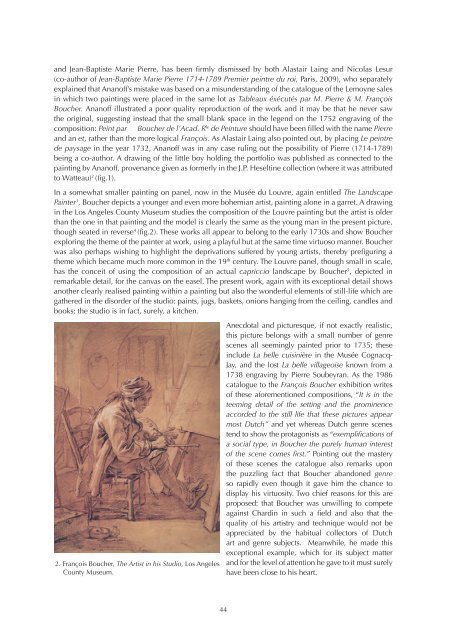Catalogue-2014-Jean-Luc-Baroni
- No tags were found...
You also want an ePaper? Increase the reach of your titles
YUMPU automatically turns print PDFs into web optimized ePapers that Google loves.
and <strong>Jean</strong>-Baptiste Marie Pierre, has been firmly dismissed by both Alastair Laing and Nicolas Lesur<br />
(co-author of <strong>Jean</strong>-Baptiste Marie Pierre 1714-1789 Premier peintre du roi, Paris, 2009), who separately<br />
explained that Ananoff’s mistake was based on a misunderstanding of the catalogue of the Lemoyne sales<br />
in which two paintings were placed in the same lot as Tableaux éxécutés par M. Pierre & M. François<br />
Boucher. Ananoff illustrated a poor quality reproduction of the work and it may be that he never saw<br />
the original, suggesting instead that the small blank space in the legend on the 1752 engraving of the<br />
composition: Peint par Boucher de l’Acad. R le de Peinture should have been filled with the name Pierre<br />
and an et, rather than the more logical François. As Alastair Laing also pointed out, by placing Le peintre<br />
de paysage in the year 1732, Ananoff was in any case ruling out the possibility of Pierre (1714-1789)<br />
being a co-author. A drawing of the little boy holding the portfolio was published as connected to the<br />
painting by Ananoff, provenance given as formerly in the J.P. Heseltine collection (where it was attributed<br />
to Watteau) 2 (fig.1).<br />
In a somewhat smaller painting on panel, now in the Musée du Louvre, again entitled The Landscape<br />
Painter 3 , Boucher depicts a younger and even more bohemian artist, painting alone in a garret. A drawing<br />
in the Los Angeles County Museum studies the composition of the Louvre painting but the artist is older<br />
than the one in that painting and the model is clearly the same as the young man in the present picture,<br />
though seated in reverse 4 (fig.2). These works all appear to belong to the early 1730s and show Boucher<br />
exploring the theme of the painter at work, using a playful but at the same time virtuoso manner. Boucher<br />
was also perhaps wishing to highlight the deprivations suffered by young artists, thereby prefiguring a<br />
theme which became much more common in the 19 th century. The Louvre panel, though small in scale,<br />
has the conceit of using the composition of an actual capriccio landscape by Boucher 5 , depicted in<br />
remarkable detail, for the canvas on the easel. The present work, again with its exceptional detail shows<br />
another clearly realised painting within a painting but also the wonderful elements of still-life which are<br />
gathered in the disorder of the studio: paints, jugs, baskets, onions hanging from the ceiling, candles and<br />
books; the studio is in fact, surely, a kitchen.<br />
2. François Boucher, The Artist in his Studio, Los Angeles<br />
County Museum.<br />
Anecdotal and picturesque, if not exactly realistic,<br />
this picture belongs with a small number of genre<br />
scenes all seemingly painted prior to 1735; these<br />
include La belle cuisinière in the Musée Cognacq-<br />
Jay, and the lost La belle villageoise known from a<br />
1738 engraving by Pierre Soubeyran. As the 1986<br />
catalogue to the François Boucher exhibition writes<br />
of these aforementioned compositions, “It is in the<br />
teeming detail of the setting and the prominence<br />
accorded to the still life that these pictures appear<br />
most Dutch” and yet whereas Dutch genre scenes<br />
tend to show the protagonists as “exemplifications of<br />
a social type, in Boucher the purely human interest<br />
of the scene comes first.” Pointing out the mastery<br />
of these scenes the catalogue also remarks upon<br />
the puzzling fact that Boucher abandoned genre<br />
so rapidly even though it gave him the chance to<br />
display his virtuosity. Two chief reasons for this are<br />
proposed: that Boucher was unwilling to compete<br />
against Chardin in such a field and also that the<br />
quality of his artistry and technique would not be<br />
appreciated by the habitual collectors of Dutch<br />
art and genre subjects. Meanwhile, he made this<br />
exceptional example, which for its subject matter<br />
and for the level of attention he gave to it must surely<br />
have been close to his heart.<br />
44
















